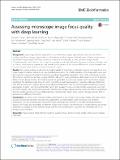Assessing microscope image focus quality with deep learning
Author(s)
Yang, Samuel J; Berndl, Marc; Michael Ando, D.; Narayanaswamy, Arunachalam; Christiansen, Eric; Hoyer, Stephan; Roat, Chris; Rueden, Curtis T; Shankar, Asim; Finkbeiner, Steven; Nelson, Philip; Yang, Samuel J.; Rueden, Curtis T.; Barch, Mariya; Hung, Jane Yen; ... Show more Show less
Download12859_2018_Article_2087.pdf (2.065Mb)
PUBLISHER_CC
Publisher with Creative Commons License
Creative Commons Attribution
Terms of use
Metadata
Show full item recordAbstract
Background
Large image datasets acquired on automated microscopes typically have some fraction of low quality, out-of-focus images, despite the use of hardware autofocus systems. Identification of these images using automated image analysis with high accuracy is important for obtaining a clean, unbiased image dataset. Complicating this task is the fact that image focus quality is only well-defined in foreground regions of images, and as a result, most previous approaches only enable a computation of the relative difference in quality between two or more images, rather than an absolute measure of quality.
Results
We present a deep neural network model capable of predicting an absolute measure of image focus on a single image in isolation, without any user-specified parameters. The model operates at the image-patch level, and also outputs a measure of prediction certainty, enabling interpretable predictions. The model was trained on only 384 in-focus Hoechst (nuclei) stain images of U2OS cells, which were synthetically defocused to one of 11 absolute defocus levels during training. The trained model can generalize on previously unseen real Hoechst stain images, identifying the absolute image focus to within one defocus level (approximately 3 pixel blur diameter difference) with 95% accuracy. On a simpler binary in/out-of-focus classification task, the trained model outperforms previous approaches on both Hoechst and Phalloidin (actin) stain images (F-scores of 0.89 and 0.86, respectively over 0.84 and 0.83), despite only having been presented Hoechst stain images during training. Lastly, we observe qualitatively that the model generalizes to two additional stains, Hoechst and Tubulin, of an unseen cell type (Human MCF-7) acquired on a different instrument.
Conclusions
Our deep neural network enables classification of out-of-focus microscope images with both higher accuracy and greater precision than previous approaches via interpretable patch-level focus and certainty predictions. The use of synthetically defocused images precludes the need for a manually annotated training dataset. The model also generalizes to different image and cell types. The framework for model training and image prediction is available as a free software library and the pre-trained model is available for immediate use in Fiji (ImageJ) and CellProfiler.
Date issued
2018-03Department
Massachusetts Institute of Technology. Department of Biological Engineering; Massachusetts Institute of Technology. Department of Chemical EngineeringJournal
BMC Bioinformatics
Publisher
BioMed Central
Citation
Yang, Samuel J. et al. "Assessing microscope image focus quality with deep learning." BMC Bioinformatics 2018, 19 (March 2018): 77 © 2018 The Author(s)
Version: Final published version
ISSN
1471-2105